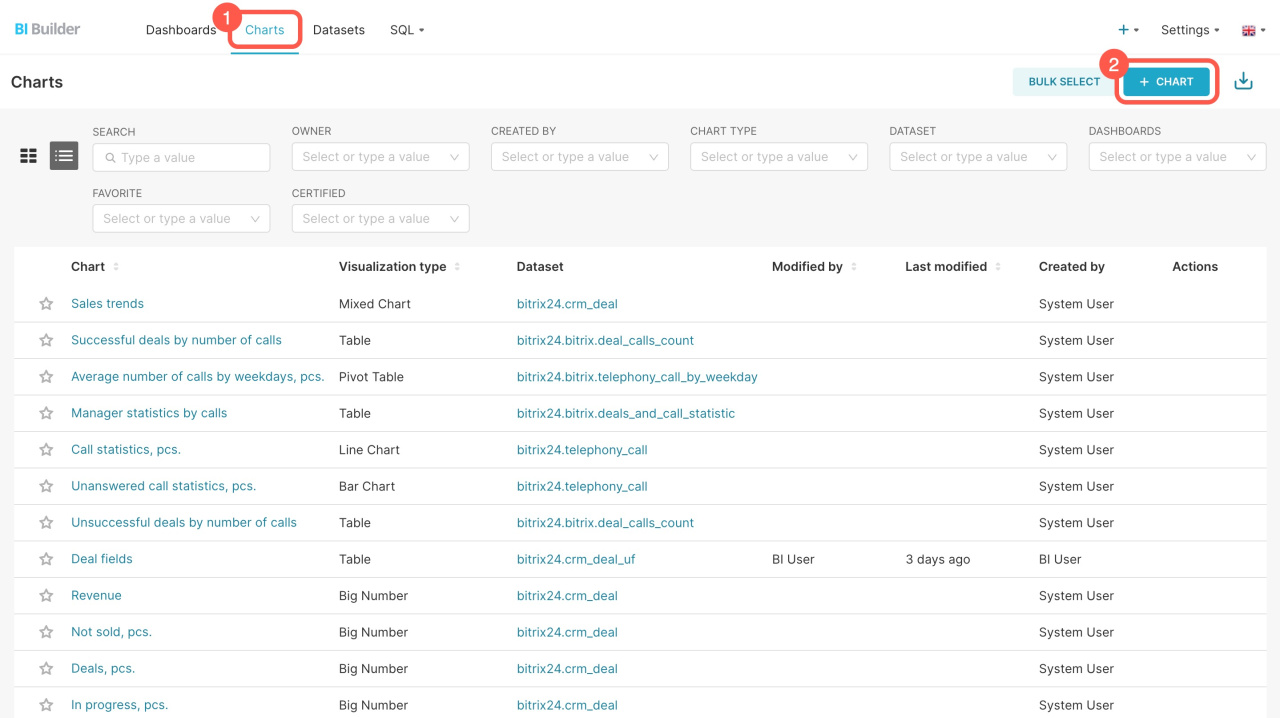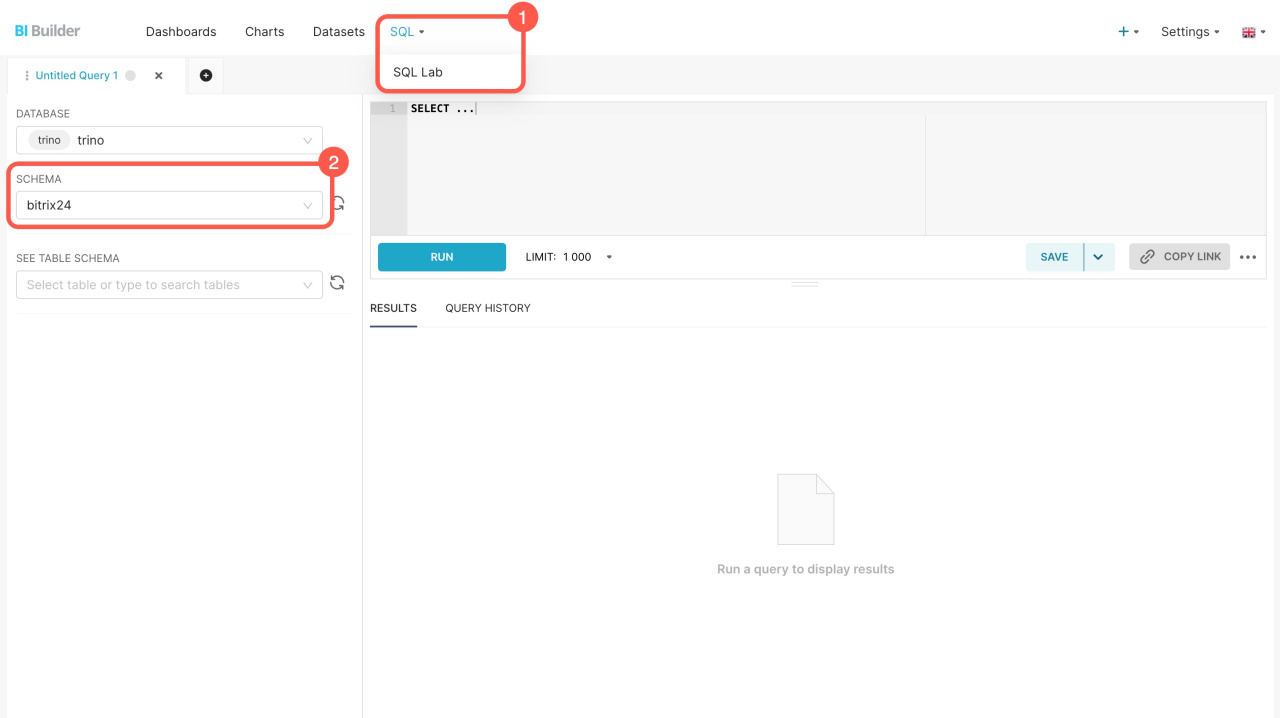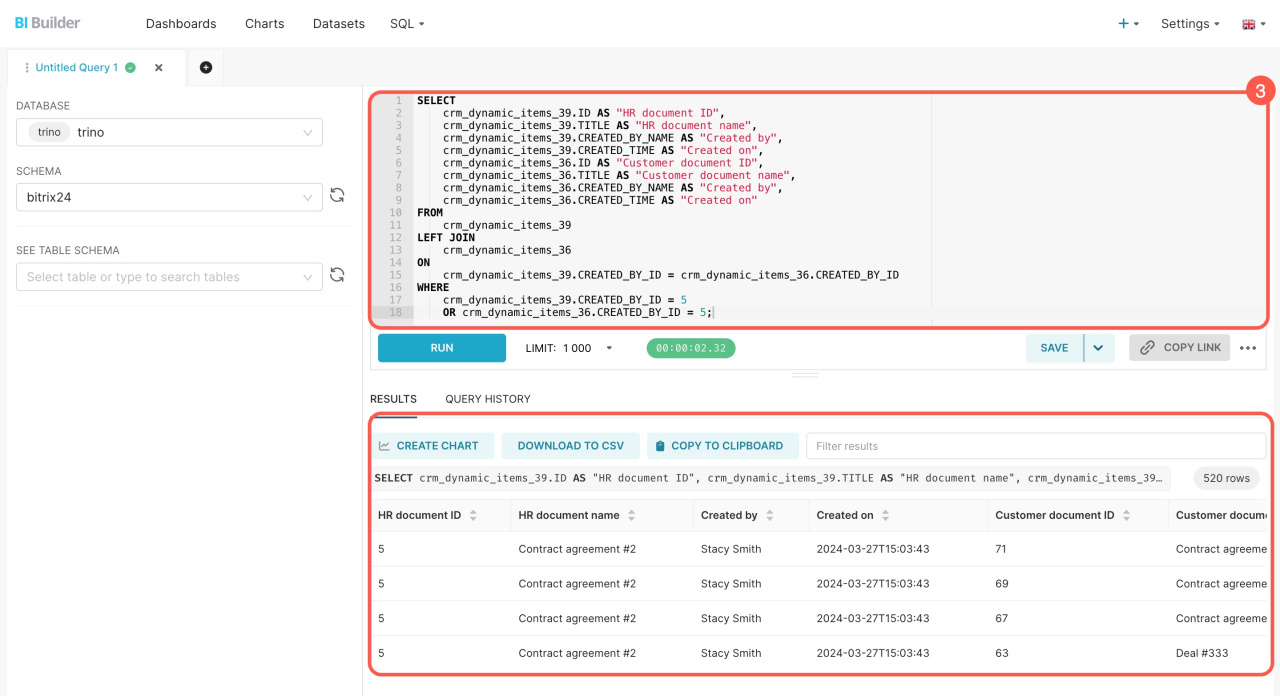Datasets contain information on HR and customer documents, invoices, and other items. Each item has multiple datasets that automatically include both standard and custom fields. Use these datasets to create charts and analyze business performance indicators.
In this article, we'll explore datasets for HR and customer documents, how to blend them, and how to create charts.
Datasets:
- Customer documents (e-Signature) — crm_dynamic_items_36
- HR documents (e-Signature for HR) — crm_dynamic_items_39
Examples:
Datasets
To start analyzing data on a dashboard, select a dataset and create a chart based on it.
Customer documents (e-Signature) — crm_dynamic_items_36: This dataset includes basic details about documents for signing, such as titles, stages, and signing deadlines. Use it to track statuses, manage deadlines, and analyze document progress through different stages.
Customer documents (e-Signature) — crm_dynamic_items_36
| Field | Description | Field type |
|---|---|---|
| ID | Unique key | Number |
| XML_ID | External ID | String |
| TITLE | Document name | String |
| CREATED_BY_ID | ID of the user who created the document | Number |
| CREATED_BY_NAME | Name of the user who created the document | String |
| CREATED_BY | ID and name of the user who created the document | String |
| UPDATED_BY_ID | ID of the user who last modified the document | Number |
| UPDATED_BY_NAME | Name of the user who last modified the document | String |
| UPDATED_BY | ID and name of the user who last modified the document | String |
| MOVED_BY_ID | ID of the user who changed the stage | Number |
| MOVED_BY_NAME | Name of the user who changed the stage | String |
| MOVED_BY | ID and name of the user who changed the stage | String |
| CREATED_TIME | Creation date and time | Date |
| UPDATED_TIME | Change date and time | Date |
| MOVED_TIME | Stage change date and time | Date |
| CATEGORY_ID | Pipeline ID | Number |
| CATEGORY_NAME | Pipeline name | String |
| CATEGORY | Pipeline name and ID | String |
| OPENED | Shows whether the item is available to all employees ("Y") or not ("N") | String |
| STAGE_ID | Stage ID | String |
| STAGE_NAME | Stage name | String |
| STAGE | Stage name and ID | String |
| PREVIOUS_STAGE_ID | Previous stage ID | String |
| BEGINDATE | Start date and time | Date |
| CLOSEDATE | End date and time | Date |
| CONTACT_ID | Contact ID | Number |
| CONTACT_NAME | Contact name | String |
| CONTACT | Contact name and ID | String |
| OPPORTUNITY | Expected amount | Number |
| IS_MANUAL_OPPORTUNITY | Shows whether the expected amount was entered manually ("Y") or not ("N") | String |
| CURRENCY_ID | Currency (e.g., "USD") | String |
| OPPORTUNITY_ACCOUNT | Amount in reporting currency | Number |
| ACCOUNT_CURRENCY_ID | Reporting currency | String |
| MYCOMPANY | ID and name of my company | String |
| MYCOMPANY_ID | My company ID | Number |
| MYCOMPANY_NAME | My company name | String |
| SOURCE_ID | Source ID | String |
| SOURCE_NAME | Source name | String |
| SOURCE | Source name and ID | String |
| SOURCE_DESCRIPTION | Source description | String |
| ASSIGNED_BY | ID and name of the user assigned as a responsible person | String |
| ASSIGNED_BY_ID | ID of the user assigned as a responsible person | Number |
| ASSIGNED_BY_NAME | Name of the user assigned as a responsible person | String |
HR documents (e-Signature for HR) — crm_dynamic_items_39: This dataset contains information about HR documents, including names, stages, and processing dates. It also includes details about the employees who created and modified the documents. Use it to track HR document statuses, manage signing deadlines, and analyze document progress through different stages.
HR documents (e-Signature for HR) — crm_dynamic_items_39
| Field | Description | Field type |
|---|---|---|
| ID | Unique key | Number |
| XML_ID | External ID for communication with external systems | String |
| TITLE | Document name | String |
| CREATED_BY_ID | ID of the user who created the item | Number |
| CREATED_BY_NAME | Name of the user who created the item | String |
| CREATED_BY | ID and name of the user who created the item | String |
| UPDATED_BY_ID | ID of the user who last modified the item | Number |
| UPDATED_BY_NAME | Name of the user who last modified the item | String |
| UPDATED_BY | ID and name of the user who last modified the item | String |
| MOVED_BY_ID | ID of the user who changed the stage | Number |
| MOVED_BY_NAME | Name of the user who changed the stage | String |
| MOVED_BY | ID and name of the user who changed the stage | String |
| CREATED_TIME | Creation date and time | Date |
| UPDATED_TIME | Change date and time | Date |
| MOVED_TIME | Stage change date and time | Date |
| CATEGORY_ID | Pipeline ID | Number |
| CATEGORY_NAME | Pipeline name | String |
| CATEGORY | Pipeline name and ID | String |
| OPENED | Shows whether the item is available to all employees ("Y") or not ("N") | String |
| STAGE_ID | Stage ID | String |
| STAGE_NAME | Stage name | String |
| STAGE | Stage name and ID | String |
| PREVIOUS_STAGE_ID | Previous stage ID | String |
| BEGINDATE | Start date and time | Date |
| CLOSEDATE | End date and time | Date |
| CONTACT_ID | Contact ID | Number |
| CONTACT_NAME | Contact name | String |
| CONTACT | Contact name and ID | String |
| MYCOMPANY | ID and name of my company | String |
| MYCOMPANY_ID | My company ID | Number |
| MYCOMPANY_NAME | My company name | String |
| SOURCE_ID | Source ID | String |
| SOURCE_NAME | Source name | String |
| SOURCE | Source name and ID | String |
| SOURCE_DESCRIPTION | Source description | String |
| ASSIGNED_BY | ID and name of the user assigned as a responsible person | String |
| ASSIGNED_BY_ID | ID of the user assigned as a responsible person | Number |
| ASSIGNED_BY_NAME | Name of the user assigned as a responsible person | String |
How to create a chart
Use datasets to create charts that help you track document creation, their current stages, and who is responsible for them. For example, the charts can display the number of signed documents and their distribution among responsible employees.
Go to the BI Builder and follow these steps:
- Open the Charts tab.
- Click + Chart.
- Select the dataset from the list. If you don't see the one you need, click Add a dataset to create a new one.
How to create a dataset - Choose a format for showing the data: big number, table, line chart, or others.
- Click Create new chart.
How to blend datasets
Combine data from HR and customer documents to identify which documents a specific employee created.
Go to the BI Builder and do the following:
- Go to SQL > SQL Lab.
- Select the bitrix24 scheme.
- Enter the SQL query and click Run.
The new set includes information from the fields that you specified in the SQL query. You can save it as a dataset to create a chart for the dashboard.
Create a chart based on a virtual dataset
If you're blending datasets for the first time, refer to the sample query.
Example of an SQL query
Here's an SQL query to extract data from two datasets: HR documents (crm_dynamic_items_39) and customer documents (crm_dynamic_items_36). You can copy it and see how it works. Replace the employee's ID before running the query.
SELECT
crm_dynamic_items_39.ID AS "HR document ID",
crm_dynamic_items_39.TITLE AS "HR document name",
crm_dynamic_items_39.CREATED_BY_NAME AS "Created by",
crm_dynamic_items_39.CREATED_TIME AS "Created on",
crm_dynamic_items_36.ID AS "Customer document ID",
crm_dynamic_items_36.TITLE AS "Customer document name",
crm_dynamic_items_36.CREATED_BY_NAME AS "Created by",
crm_dynamic_items_36.CREATED_TIME AS "Created on"
FROM
crm_dynamic_items_39
LEFT JOIN
crm_dynamic_items_36
ON
crm_dynamic_items_39.CREATED_BY_ID = crm_dynamic_items_36.CREATED_BY_ID
WHERE
crm_dynamic_items_39.CREATED_BY_ID = 5
OR crm_dynamic_items_36.CREATED_BY_ID = 5;
SELECT: Chooses which data to extract. For example, the SELECT crm_dynamic_items_39.ID AS "HR document ID" part does the following:
- Selects the HR document
IDfrom thecrm_dynamic_items_39dataset - Assigns it the name
HR document ID - Displays the result in a separate column
FROM: Specifies the main table for the query, such as the crm_dynamic_items_39 table that holds HR document information.
LEFT JOIN: Connects crm_dynamic_items_39 and crm_dynamic_items_36 datasets, combining information on HR and customer documents.
WHERE: Filters the query results to show the documents created by a specific employee. The condition WHERE crm_dynamic_items_39.CREATED_BY_ID = 5 OR crm_dynamic_items_36.CREATED_BY_ID = 5 displays documents created by the employee with ID 5 from both tables. Remove this condition to show documents from all employees.
In brief
-
Datasets contain information on HR and customer documents, invoices, and other items.
-
Each item has multiple datasets that automatically include both standard and custom fields.
-
There are two datasets for working with documents: HR documents (crm_dynamic_items_39) and customer documents (crm_dynamic_items_36).
-
Use datasets to create charts and analyze metrics, such as the number of signed documents, processing times, and their distribution among responsible employees.
-
Blend datasets to identify which documents a specific employee created. To do this, write an SQL query, save the result as a dataset, and create a chart.





